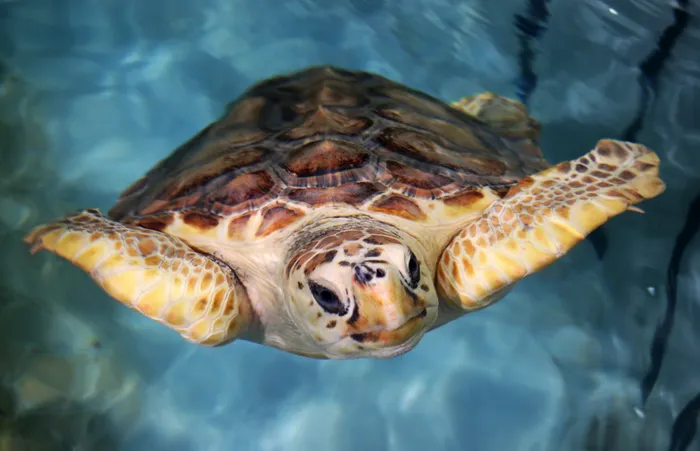uShaka Sea World’s animal hospital sees increase in patients over the past two years

Loggerhead turtle Munchkin has been at the Saambr’s Sea Turtle Hospital at uShaka Sea World since she was a baby having sight problems. Picture: Tumi Pakkies/African News Agency(ANA)
Durban — Over the past two years, there has been an increase in the number of animal patients at Saambr’s Sea Turtle Hospital at uShaka Sea World.
This was according to lead quarantine aquarist Malini Pather, who runs the turtle programme. She said that in November and December, they had at least two animals brought in per week.
“On the KZN coast we have had washed-up carcasses and stranded animals. Over the past two years we’ve seen an increase. We are trying to figure out why this is. Last year in September, October, November and December we had a number of sub-adult turtles brought in which included green turtles, loggerheads and leatherbacks.”
Pather urged the public not to push washed-up turtles back into the sea.
“When you find a turtle washed up on shore it’s a sign that something is wrong and it is sick. It has lungs just under its shell and when it is sick the lungs get tired and that’s when you find them washed up or floating unable to dive. Pushing it back into the water does not help it,” she said.
A recent patient but no stranger was Calypso, a green turtle released back into its natural habitat last February by Pather’s team. Calypso was back after experiencing buoyancy problems which might have seen a boat hit and crack his carapace (shell).
Calypso’s blood results have shown that he also has a kidney infection, something Pather said was worrying.
She said that the animal was recently found by people on the South Coast. Pather said before Calypso’s release the turtle had arrived at the centre in 2018 after being found inside a backpack 15km inland by a banana farmer on the South Coast.
She said they were able to identify Calypso through a satellite tag they attached to animals that they released in a bid to track their movements.

Not all animals were able to be released as the conditions they suffered from would hinder them in their natural habitat.
One such turtle was Orian, whose last recorded weight was 42.4kg. She was brought to the centre after being found half-buried in the sand on a beach in Sodwana in October.
“She has a severe cataract in one eye while the other has partial. She has some vision. We have trained her with a target board – when she sees the sign she knows that she will get food.”
She said that the turtle had been on exhibition when they noticed that her eyesight had become worse.
“We brought her back to rehabilitation and have retrained her using a bigger sign and sounds. She is responding nicely to sounds.”
Pather said that uShaka was now Orian’s permanent home.
She said that in October they also had a green turtle, Odian, brought in and she was making progress, moving from being tube fed to feeding on her own.
“She also had buoyancy problems and came in underweight. We didn’t expect her to make it. Now she’s eager to eat. She started eating on her own last month and on a good day she will eat 1kg of food.”

Daily News
WATCH: KZN South Coast lifeguards free tangled turtle at sea
Turtle entangled in fishing nets, fishing lines and ropes released back into the ocean after life-saving ‘pit stop’
LOOK: Turtle with front flippers bitten off by tiger shark released back into the ocean after 11 months of rehabilitation
Turtle rehabilitated for almost 4 years is back at uShaka Sea World with an injury